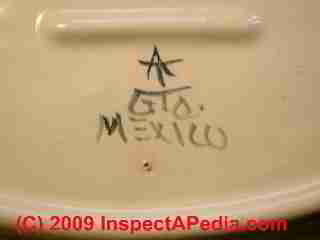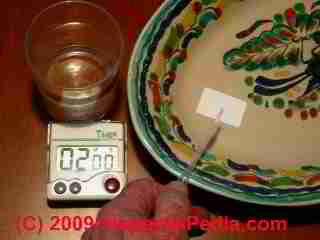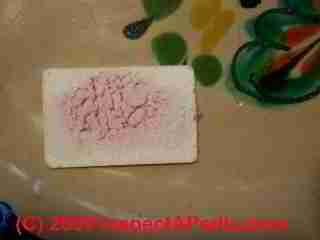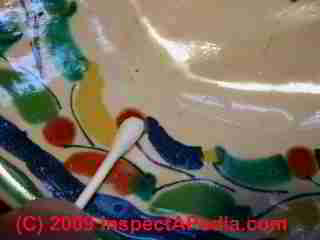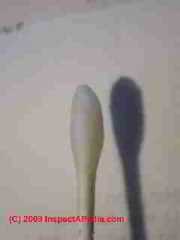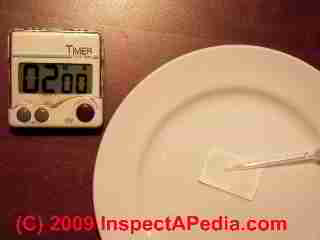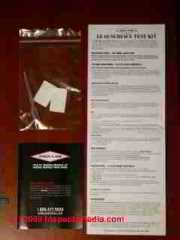 Home Test Kit for Lead on Building Surfaces - Test Kit Review
Home Test Kit for Lead on Building Surfaces - Test Kit Review
- POST a QUESTION or COMMENT about buying and using lead paint test kits in homes, including how to assess the reliablity of home test kits for lead contamination on surfaces and in settled dust
Home test kits for lead:
Here we demonstrate and review the performance of an over-the-counter home test kit for lead. We describe simple procedures we used to confirm that a home lead test kit was actually working reliably. We describe the lead test kit contents and we illustrate how the kit is used.
Our photo at page top shows the contents of the Pro-Lab® home test kit for lead on building surfaces.
InspectAPedia tolerates no conflicts of interest. We have no relationship with advertisers, products, or services discussed at this website.
Lead Testing Kit for Home Use
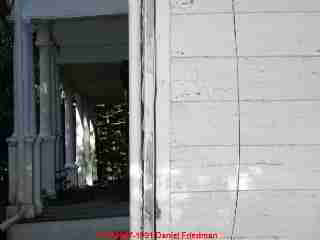 We purchased a readily-available home test kit for lead on building surfaces and followed the kit instructions. Home test kits for lead on surfaces include a treated wiping pad that is wiped across the test surface.
We purchased a readily-available home test kit for lead on building surfaces and followed the kit instructions. Home test kits for lead on surfaces include a treated wiping pad that is wiped across the test surface.
A change in color (to red or pink) will in normal circumstances indicate the presence of lead that can be released by touch or by placing food on such a surface.
The same company, ProLab®, provides other home test kits including a test for lead in water - a service that is widely available including from local health departments and from private water testing laboratories.
Wipe type lead test kits are suitable for testing a variety of surfaces including
- Painted building surfaces such as the Colonial era home shown at left
- Painted or other children's toys
- Glazed ceramic dishes
- Lead crystal glassware
- Soil (dirt)
- Pipe surfaces to confirm lead piping (not really necessary as you can determine this by visual inspection in most cases)
- Many other surfaces. Special steps are needed when testing red-painted surfaces in order to assure that red pigment is not confounding the test and giving a false indication of the presence of lead. Additional steps are needed when testing painted surfaces: the painted surface is notched to expose the inner layers of paint and the test pad is held applied to that surface for the duration of the test interval.
What the Home Test Kit for Lead Contains
We purchased a ProLab® Lead Surface Test Kit from a local building supply store for $9.98 plus tax and brought it to our forensic lab. Our photo (left) shows the contents of the lead surface test kit. ProLab's brochure notes that this lead surface wipe test kit can detect lead levels down to 5 parts per million - 5ppm.
The test kit is sealed in a plastic pack, perhaps to assure that the contents are kept clean, uncontaminated, and to protect from pilferage in the store. The lead surface test kit package promises that the kit contains six tests. Here is what our kit included:
- Instructions for conducting the lead surface test -
the inner surfaces of the lead surface test kit paper cover contains clear, easy to follow instructions. Don't throw this paper away. Read it. - A plastic eye dropper
that you'll use to place four drops of water onto your test pad. We used tap water as the instructions didn't specify that distilled or otherwise guaranteed lead-free water be used for this procedure. - A plastic bag containing two paper lead test wipes that provide for up to six lead surface tests.
If you read the instructions carefully (as we failed to do) you'll see that these two pads, each a bit over an inch long, are to be cut into three pieces to yield a total of six lead surface wipe tests. - A product brochure
advertising other ProLab® test kit products.
Lead Test Kit Experimental Design
We purchased our lead surface wipe test kit at a local building supply store. We read and followed the kit's instructions carefully. We performed two tests:
- Testing a known lead-contaminated surface: We tried the lead surface test kit on the surface of an antique Mexican ceramic dish known to contain lead glazing.
We followed this simple low-tech lead test kit performance test with a second step to check for false positives - indicating lead where it is absent. - Testing a surface known not to contain lead: As a control, we tried out the lead test surface kit on the surface of a modern ceramic plate known to be lead-free.
Below we describe the steps in the lead test kit procedure as well as the results of these simple experiments.
Steps in Testing a Surface for Lead Contamination
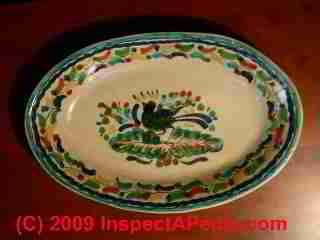
We washed and dried our test surface, an antique Mexican platter (photos above) whose glazing was reported by the seller as containing lead. We didn't want any possible food, debris, or other residue to contaminate our test surface.
Obviously if you're testing a building wall you won't have to power-wash the wall. But if testing an outdoor surface that is dirty you'll want to remove that surface dirt first too.
Incidentally, modern ceramic ware as well as other consumer products purchased in Mexico are made from lead-free materials - the hazards of lead poisoning are widely recognized. Start by asking your vendor if you have any question about the use of lead in the product. Finish by testing products for lead if there is any doubt about their condition.
We collected our test platter, an egg timer (the instructions say to wipe the pad on the test surface slowly for two minutes), our eyedropper and a glass of clean tap water.
We dripped four drops of clean water onto the test pad (photo at left) as it sat on our test surface, then we wiped slowly over most of the platter surface for the required two minutes.
We inspected our test pad for a color change at the end of this time.
Results of Surface Test for Lead Contamination
The test pad turned pink, indicating that the platter glaze contains lead.
We won't use this antique platter for food.
Next we also conducted a pigment-leaching test (described below) recommended by ProLab® to make sure that none of the red glazing was itself leaching red pigment onto our lead surface test pad. Pigment leaching could give a false positive for lead contamination.
Testing the Surface for Red Pigment Leaching
Our photo shows our clean cotton swab moistened with distilled white vinegar being applied to a red area of our lead-positive ceramic platter.
The ProLab® lead surface test kit instructions recommend testing red pigmented surfaces to be sure that the test is not falsely indicating the presence of lead (the pad turns red or pink) when what is really happening is that the test is picking up red pigment from the test surface. This is a likely hazard with red painted surfaces and is less likely with ceramics, but we performed this check anyway.
Our photo of the swab at the end of our test (above) shows that no red pigment was picked up by the swab. This result confirms that our earlier test that indicated the presence of lead was accurate and that it was not confounded by removable red pigment from the test surface.
Our Q-tip shows that no red color was lifted during our test of the red portions of surface of our test platter.
Steps in Testing a Control Surface for Absence of Lead Contamination
We performed this second lead surface wipe test as a control to confirm that the home test kit for lead would not indicate the presence of lead contamination (by mistake) on a surface that is lead-free.
We repeated the two minute surface wipe of our control surface.
If we had not already been pretty sure that our platter contained lead, we would have added a third test for lead on a second known-lead-containing surface as well.
But our particular home test kit contained only two tests -
see What the Home Test Kit for Lead Contains, above.
Results of Control Test on a Known No-Lead Surface
After the required two minutes of slow wiping of the test plate surface with our second test pad moistened with four drops of water from the same water source, the lead surface test wipe pad remained plain white - there was no color change. This indicated that no lead was detected on the surface of our control plate, and it confirmed that the tests appeared to be working normally.
We could have cut our first test wipe pad in half to be extra cautious in this procedure, testing half on each of the two plates. That would have reduced the chances of an effect of variation in chemical treatment between our two test pads.
Conclusions Regarding the ProLab Lead Surface Wipe Test
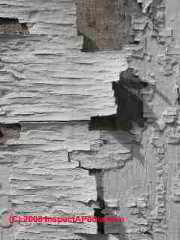 ProLab® has provided an easy, reliable lead surface test:
ProLab® has provided an easy, reliable lead surface test:
The ProLab® lead surface test kit was easy to use, quick, and appeared to be accurate and reliable.
Fragile test wipe pads:
We noticed, however, that the paper test wipe pads disintegrate easily. Our photo at Results of Surface Test for Lead Contamination, above, shows some pilling and rolling up of paper fragments on the test wipe.
This might be one of the reasons why the manufacturer emphasizes to wipe the lead test surface slowly. But the fragility of these paper wipes mean that it would be difficult to wipe a rough, alligatored painted surface on a building (photo at left) for the full two minutes.
For a rough surface such as that in our photo (left) you may be able to complete the test by simply holding the moistened test pad on the surface for two minutes, or make the notched surface cut recommended in the instructions before holding the test pad on the surface.
Wash the ceramic surface:
If testing a surface that might be contaminated with other materials you might want to gently wash or clean it first to be sure you're not confusing your test by extraneous chemicals.
Test for red pigment release before testing for lead:
because the lead wipe test may leave a thin coating of residue of red (lead positive) test chemical on the tested surface, if you are going to perform the red pigment release test, either do this test before you test for lead with the wipe, or be sure to wash any test chemical residue off of the surface before testing for red pigment.
Otherwise red (lead positive) chemical may show up on your cotton swab and it may be mistaken for released pigment.
Remember to wash off the vinegar. If your test surface is dishware or a toy or similar item, you also will want to wash off the lead test chemical residue after using the moistened lead surface wiping pad.
...
Continue reading at LEAD POISONING HAZARDS GUIDE - topic home, or select a topic from the closely-related articles below, or see the complete ARTICLE INDEX.
Or see these
Recommended Articles
- LEAD POISONING HAZARDS GUIDE - home
- LEAD in AIR, EMISSIONS STANDARDS
- LEAD BASED PAINT-USES in BUILDINGS
- LEAD in the BODY
- LEAD CONTAMINATION HAZARDS in the HOME
- WHAT TO DO ABOUT LEAD in the HOME
- LEAD CONTAMINATION in WATER, HOW to TEST
- LEAD IN DRINKING WATER, HOW to REDUCE
- LEAD EXPOSURE HAZARDS INDOORS
- LEAD in FLOORING PRODUCTS & POLISHES
- LEAD HAZARDS & FEAR: ENVIRO-SCARE
- LEAD HAZARDS in REMODELING
- LEAD INFORMATION, US GOVERNMENT
- LEAD PIPES in BUILDINGS
- LEAD POISONING EMERGENCY HELP NUMBERS
- LEAD POISONING SYMPTOMS
- LEAD ROOFING & FLASHING
- LEAD TESTS for the FAMILY
- LEAD TESTS for the HOME
- LEAD TEST KIT for HOME USE
Suggested citation for this web page
LEAD TEST KIT for HOME USE at InspectApedia.com - online encyclopedia of building & environmental inspection, testing, diagnosis, repair, & problem prevention advice.
Or see this
INDEX to RELATED ARTICLES: ARTICLE INDEX to BUILDING ENVIRONMENT
Or use the SEARCH BOX found below to Ask a Question or Search InspectApedia
Ask a Question or Search InspectApedia
Questions & answers on buying and using lead paint test kits in homes, including how to assess the reliablity of home test kits for lead contamination on surfaces and in settled dust
Try the search box just below, or if you prefer, post a question or comment in the Comments box below and we will respond promptly.
Search the InspectApedia website
Note: appearance of your Comment below may be delayed: if your comment contains an image, photograph, web link, or text that looks to the software as if it might be a web link, your posting will appear after it has been approved by a moderator. Apologies for the delay.
Only one image can be added per comment but you can post as many comments, and therefore images, as you like.
You will not receive a notification when a response to your question has been posted.
Please bookmark this page to make it easy for you to check back for our response.
Our Comment Box is provided by Countable Web Productions countable.ca
Citations & References
In addition to any citations in the article above, a full list is available on request.
- Pro-Lab® lead surface test kits and other test kits are available at Home Depot® as well as other retail outlets. ProLab, a Weston Florida company can be reached at 800-427-0550. The company's website is www.prolabinc.com .
- Thanks to Dr. John D. Shane, PhD., www.prolabinc.com, for correcting errors in the original version of this article. Dr. Shane who is presently with ProLab was previously the Director of Research at McCrone Research Institute where the author attended classes in microscopy.
- "Standard Operating Procedure for Determining Lead (Pb) and Its Availability in Children's Metal Jewelery", US CPSC, 2/3/2005
- SOP for Determining Lead (Pb) and And Its Availability in Children's Jewelry
- Toy Industry Policy on Lead in Toys [dead link 2023/12/05 vinyltoys.com/docs/hm/icti_lead [dot] html ] , International Council of Toy Industries, October 8, 1997
"The voluntary standard established in the United States under ASTM F-963 and the European standard under EN-71 for soluble lead in toys (lead which may migrate from the toy and be ingested by the child) is 90 parts-per-million. At that level, any intentional use of lead in paints or other surface coatings containing lead would immediately put the toy over the permitted limit."
"Under federal law, the US Consumer Product Safety Commission (CPSC) enforces a standard for total lead of 600 ppm. Recently, the CPSC refused to lower the lead limit in paint and other similar surface coating materials to 100 ppm after finding that most paints sold in the United States were already at or below that level and, therefore, these materials did not present an unreasonable risk of injury warranting further government regulation."
- In addition to citations & references found in this article, see the research citations given at the end of the related articles found at our suggested
CONTINUE READING or RECOMMENDED ARTICLES.
- Carson, Dunlop & Associates Ltd., 120 Carlton Street Suite 407, Toronto ON M5A 4K2. Tel: (416) 964-9415 1-800-268-7070 Email: info@carsondunlop.com. Alan Carson is a past president of ASHI, the American Society of Home Inspectors.
Thanks to Alan Carson and Bob Dunlop, for permission for InspectAPedia to use text excerpts from The HOME REFERENCE BOOK - the Encyclopedia of Homes and to use illustrations from The ILLUSTRATED HOME .
Carson Dunlop Associates provides extensive home inspection education and report writing material. In gratitude we provide links to tsome Carson Dunlop Associates products and services.


